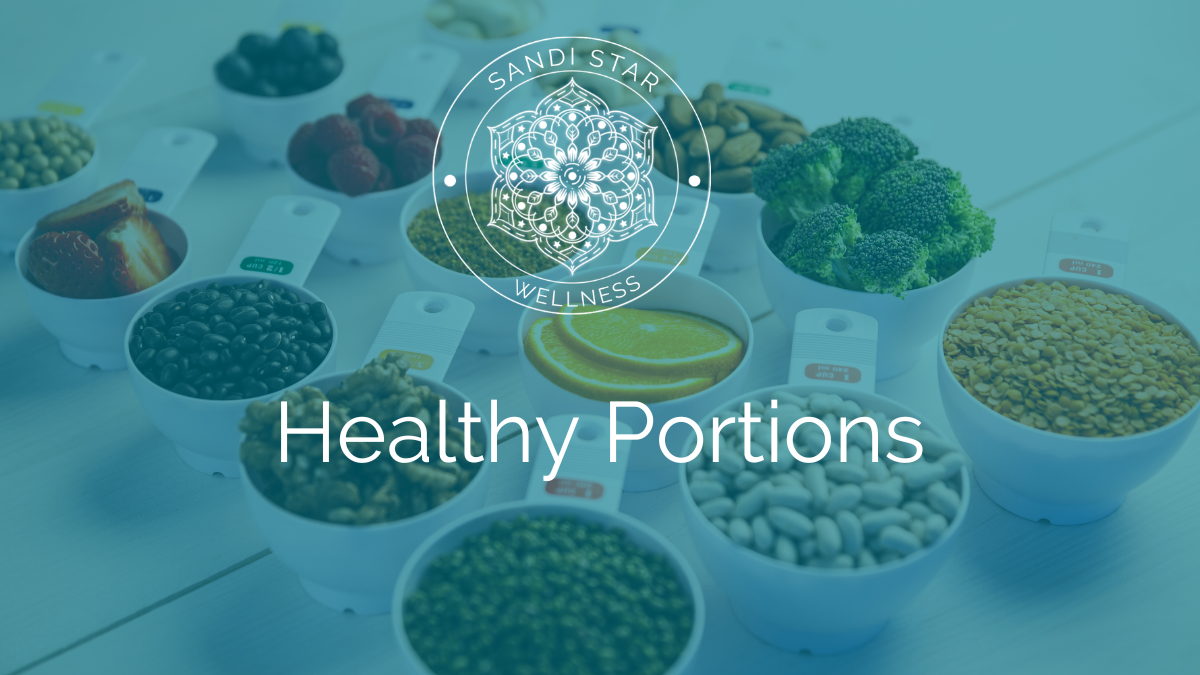
17 Oct Healthy Portions
Tips for Healthy Portion Control
There is a lot of information out there on diets that seem overwhelming at times. Seems each year there is a shift in what’s in now and what’s out. Remember the low fat phase? I still hear people say they stay away from all fats thinking they will make them fat. Yikes, that makes my hair stand up. That’s another article to write for sure. The best way to look at your diet which by the way simply means assembly of food, is to count quality not calories, keeping portions in mind. The list coming up will give you an idea of what optimal foods are.
There is some great information out there as to what a good portion is however they include a lot of starches which isn’t always a good thing to eat a lot of, especially if we need to address blood sugar. I’d like to approach this a bit different. First of all, knowing what foods are healthy for you giving optimal absorption is key in creating a healthy diet.
Once you know what foods work optimal for you it’s good to know what a good portion size is and what your plate should typically look like.
OPTIMAL PROTEIN CHOICES:
⦁ Organic/Hormone-Free Chicken and Poultry
⦁ Lamb
⦁ Organic – Grass Fed Beef
⦁ Wild Caught White Fish & Salmon
⦁ Organic Eggs
⦁ Beans – Legumes and Lentils
⦁ Nuts and seeds (with the exception of peanuts)
⦁ Sheep Milk or Goat Cheese (if tolerated)
⦁ Hemp
OPTIMAL FAT CHOICES:
⦁ Flaxseed and Flax Oil
⦁ Walnut Oils
⦁ Extra Virgin Olive Oil
⦁ Coconut Milk
⦁ Coconut Oil
⦁ Avocado
⦁ Raw Nuts and Seeds
GLUTEN FREE GRAINS:
⦁ Quinoa
⦁ Millet
⦁ Brown and/or Wild Rice
⦁ Amaranth
⦁ Arrowroot
⦁ Teff
⦁ Nut Flours are a GREAT substitute as are Bean Flours
BEVERAGES:
⦁ Herbal Teas
⦁ Spring Water
⦁ Vegetable Juicing (make your own with raw greens, etc.,)
⦁ Unsweetened Almond Milk or Coconut Milk
⦁ Coconut Water (great for electrolytes)
OPTIMAL NON-STARCHY VEGETABLE CHOICES:
⦁ Arugula
⦁ Asparagus
⦁ Bamboo shoots
⦁ Bean sprouts
⦁ Beet greens
⦁ Bell peppers (red, yellow, green)
⦁ Broccoli
⦁ Brussels sprouts
⦁ Cabbage
⦁ Cassava
⦁ Cauliflower
⦁ Celery
⦁ Chicory
⦁ Collard greens
⦁ Cucumber
⦁ Dandelion greens
⦁ Eggplant
⦁ Endive
⦁ Fennel
⦁ Garlic
⦁ Ginger root
⦁ Jicama (raw)
⦁ Jalapeno peppers
⦁ Kale
⦁ Lettuce
⦁ Mustard greens
⦁ Onions
⦁ Parsley
⦁ Radishes
⦁ Shallots
⦁ Spinach
⦁ Spaghetti squash
⦁ Summer squash
⦁ Swiss chard
⦁ Tomatoes
⦁ Turnip greens
⦁ Watercress
HIGH FIBER STARCHY CARBOHYDRATE CHOICES:
⦁ Squash (acorn, butternut, winter)
⦁ Artichokes
⦁ Leeks
⦁ Lima beans
⦁ Pumpkin
⦁ Sweet potatoes or yams
⦁ Legumes
⦁ Black beans
⦁ Chick peas (garbanzo)
⦁ French beans
⦁ Great Northern beans
⦁ Kidney beans
⦁ Lentils
⦁ Mung beans
⦁ Navy beans
⦁ Pinto beans
⦁ Split peas
⦁ White beans
⦁ Yellow beans
Beans are also a great protein source – replace a few meals per week with vegetarian options
FRUIT CHOICES:
Low Glycemic Index:
⦁ Berries (blackberries, blueberries, boysenberries, elderberries, gooseberries, raspberries,
strawberries)
Moderate Glycemic Index:
⦁ Cherries
⦁ Pears
⦁ Fresh apricots
⦁ Melons
⦁ Oranges
⦁ Peaches
⦁ Plums
⦁ Grapefruit
⦁ Pitted Prunes
⦁ Apples
⦁ Plums
⦁ Kiwi fruit
⦁ Lemons
⦁ Limes
⦁ Nectarines
⦁ Tangerines
⦁ Passion Fruit
⦁ Persimmons
⦁ Pomegranates
High Glycemic Index (eat sparingly):
⦁ Banana
⦁ Pineapple
⦁ Grapes
⦁ Watermelon
⦁ Mango
⦁ Papaya
Moderate- and High-Glycemic Vegetables
· Potato
· Beetroot
· Sweet potato
· Pumpkin
Low-Glycemic Vegetables
· Carrots
· Black beans
· Chickpeas
· Non-starchy vegetables (asparagus, broccoli, cucumber, greens, etc.)
CONDIMENTS & Misc:
⦁ Lemon
⦁ Lime
⦁ Cayenne Pepper
⦁ Sea Salt
⦁ Garlic
⦁ Fresh Herbs and Spices – eat a variety for anti-fungal, anti-inflammatory and digestive support
⦁ Organic low sodium Chicken, Beef or Vegetable Broth
Eating Optimal Foods is key however we can overdo a good thing as well. How many times have you eaten a cup of nuts not knowing 2 ounces is a recommended portion so your body can break down the fats? Below is a simple list to give you an idea of what a portion looks like:
PORTION SIZE:
⦁ Vegetables or fruit is about the size of your fist.
⦁ Pasta is about the size of one scoop of ice cream.
⦁ Meat, fish, or poultry is the size of a deck of cards or the size of your palm (minus the fingers).
⦁ Snacks such as pretzels and chips is about the size of a cupped handful (not two).
⦁ Nuts, about 2 ounces or ¼ cup
⦁ Nut butters, 2 tablespoons
⦁ Oil – 2 tablespoons
⦁ Apple is the size of a baseball.
⦁ Potato is the size of a computer mouse.
⦁ Pancake is the size of a CD.
⦁ Steamed rice (whole grains) is the size of a cupcake wrapper or 1/3 cup
⦁ Cheese is the size of a pair of dice or the size of your whole thumb (from the tip to the base).
WHAT A PLATE SHOULD LOOK LIKE:
For the most part, your plate should be two servings of veggies (greens mostly and if you have a root veggie make sure it’s the size of a computer mouse), lean protein (size of a deck of cards) and a small amount of whole gluten free grains on occasion (I don’t eat grains at every meal) which would be 1/3 cup cooked.


